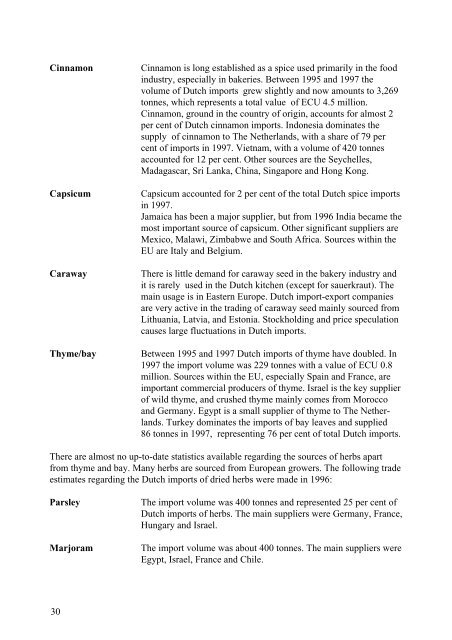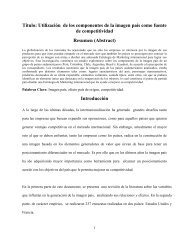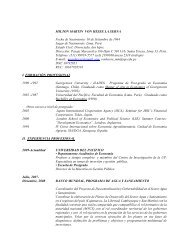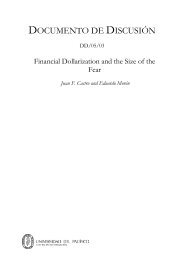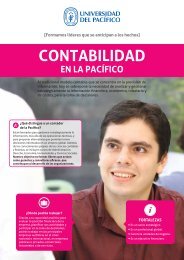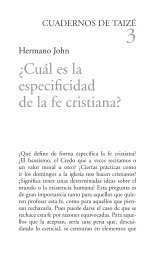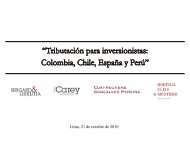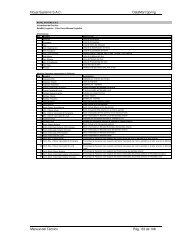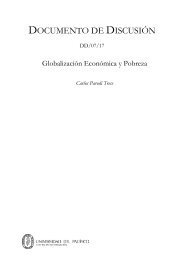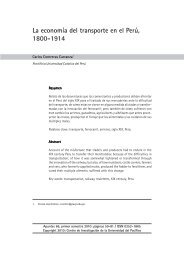Create successful ePaper yourself
Turn your PDF publications into a flip-book with our unique Google optimized e-Paper software.
Cinnamon Cinnamon is long established as a spice used primarily in the food<br />
industry, especially in bakeries. Between 1995 <strong>and</strong> 1997 the<br />
volume of Dutch imports grew slightly <strong>and</strong> now amounts to 3,269<br />
tonnes, which represents a total value of ECU 4.5 million.<br />
Cinnamon, ground in the country of origin, accounts for almost 2<br />
per cent of Dutch cinnamon imports. Indonesia dominates the<br />
supply of cinnamon to The Netherl<strong>and</strong>s, with a share of 79 per<br />
cent of imports in 1997. Vietnam, with a volume of 420 tonnes<br />
accounted for 12 per cent. Other sources are the Seychelles,<br />
Madagascar, Sri Lanka, China, Singapore <strong>and</strong> Hong Kong.<br />
Capsicum Capsicum accounted for 2 per cent of the total Dutch spice imports<br />
in 1997.<br />
Jamaica has been a major supplier, but from 1996 India became the<br />
most important source of capsicum. Other significant suppliers are<br />
Mexico, Malawi, Zimbabwe <strong>and</strong> South Africa. Sources within the<br />
EU are Italy <strong>and</strong> Belgium.<br />
Caraway There is little dem<strong>and</strong> for caraway seed in the bakery industry <strong>and</strong><br />
it is rarely used in the Dutch kitchen (except for sauerkraut). The<br />
main usage is in Eastern Europe. Dutch import-export companies<br />
are very active in the trading of caraway seed mainly sourced from<br />
Lithuania, Latvia, <strong>and</strong> Estonia. Stockholding <strong>and</strong> price speculation<br />
causes large fluctuations in Dutch imports.<br />
Thyme/bay Between 1995 <strong>and</strong> 1997 Dutch imports of thyme have doubled. In<br />
1997 the import volume was 229 tonnes with a value of ECU 0.8<br />
million. Sources within the EU, especially Spain <strong>and</strong> France, are<br />
important commercial producers of thyme. Israel is the key supplier<br />
of wild thyme, <strong>and</strong> crushed thyme mainly comes from Morocco<br />
<strong>and</strong> Germany. Egypt is a small supplier of thyme to The Netherl<strong>and</strong>s.<br />
Turkey dominates the imports of bay leaves <strong>and</strong> supplied<br />
86 tonnes in 1997, representing 76 per cent of total Dutch imports.<br />
There are almost no up-to-date statistics available regarding the sources of herbs apart<br />
from thyme <strong>and</strong> bay. Many herbs are sourced from European growers. The following trade<br />
estimates regarding the Dutch imports of dried herbs were made in 1996:<br />
Parsley The import volume was 400 tonnes <strong>and</strong> represented 25 per cent of<br />
Dutch imports of herbs. The main suppliers were Germany, France,<br />
Hungary <strong>and</strong> Israel.<br />
Marjoram The import volume was about 400 tonnes. The main suppliers were<br />
Egypt, Israel, France <strong>and</strong> Chile.<br />
30


